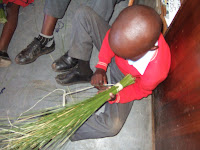Last week, two of the schools in Mokhotlong were visited by teachers from their partner schools in Wales: Richmond Park in Carmarthen and Ysgol Llanbedr Pont Steffan in Lampeter. Their host schools decided to take them to see the Katse Dam in the middle of Lesotho, so we teachers in the other town schools went along too.
Katse Dam is the largest dam in Lesotho. You can see it here –
the dam wall is 185 metres tall and 710 metres wide.
Rainwater in the mountains of Lesotho is collected and stored
in reservoirs behind large dams like this one. The water is then sent through
tunnels to South Africa for people to drink.
The government of Lesotho is paid by the South Africans for
the water but not everyone is happy about this. The soil in the valleys near
the rivers in Lesotho is the most fertile – the best land for people to grow
crops on. When these valleys are flooded to create a reservoir of water, the
land is lost. The local people then have to move to other places with soil that
is not so good for growing their crops in.






